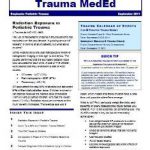Deep venous thrombosis (DVT) is always a concern in trauma patients. Patients with spine and spinal cord injury have been shown to be at higher risk for DVT than many other trauma patients, with a reported incidence ranging from 5% to 70%. However, a few studies have suggested that paraplegics are actually at higher risk than quadriplegics. This just doesn’t seem to make sense.
A NTDB study was done to look at this issue. A total of 18,000+ patients were reviewed, and correlations with spinal cord injury level, demographics, comorbidities and associated injuries were determined.
High cervical (C1-4) and lumbar cord injuries had the lowest DVT rates at about 3%. Lower cervical (C5-7) and high thoracic (T1-6) had the highest rates at 5% and 6.3%, respectively. The lower thoracic spine was about 4.5%. These differences were statistically significant, and the authors also confirmed the usual DVT suspects as being significant (increasing age, increasing injury severity, TBI, chest trauma, and male gender).
Bottom line: Yes, this study does confirm the suspicion that paraplegics are at higher risk for DVT than quadriplegics. Why? We don’t know. And although it is statistically significant, is it clinically significant? I’m not so sure. We’re talking another 1-2 spinal cord injured patients with DVT for every 100 quadriplegics treated. How many do you admit per year? At my institution, this means that there will be 1 additional DVT in this patient group every three to four years. It’s hard to justify making any changes to existing protocols based on these new facts. Always look at the practical side of what you read!
Related posts:
Reference: Risk of venous thromboembolism after spinal cord injury: not all levels are the same. J Trauma 71(5):1241-1245, 2011.




